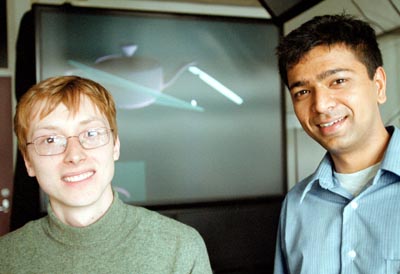Untitled Document
"Always Something Weird Happening in Holland"
Sriram Subramanian and Dzmitry Aliakseyeu have about
800 days to go as Ph.D. students working on 'multi-modal interaction'
at IPO, center for user system interaction. In different ways,
they are both testing the possibilities of the 'augmented reality
platform', cutting-edge technology that you might expect to find
on the starship Enterprise if it actually existed. Cursor talked
to them about their life and work in Eindhoven.
 The Ph.D. students' office is kitted
out with tracking devices, a 72-inch stereo back projection screen,
an electronic drawing board and various wireless/wired Wacom LCD
tablets. "In a nutshell, we are looking at ideas for the
development of new tools to aid scientific visualisation,"
says Subramanian. "I'm working on ways to visualise medical
and geological data. Dima is part of a project working on the
visualisation and manipulation of architectural data."
The Ph.D. students' office is kitted
out with tracking devices, a 72-inch stereo back projection screen,
an electronic drawing board and various wireless/wired Wacom LCD
tablets. "In a nutshell, we are looking at ideas for the
development of new tools to aid scientific visualisation,"
says Subramanian. "I'm working on ways to visualise medical
and geological data. Dima is part of a project working on the
visualisation and manipulation of architectural data."
Subramanian and Aliakseyeu are from Bangalore in India and Minsk
in Belarus, respectively. Their two home cities that have a long-standing
kinship relationship. "There is a square in Minsk named for
Bangalore," says Aliakseyeu. "It's strange the two of
us should end up in the same office such a long way from home."
Aliakseyeu came to Eindhoven with the help of Ph.D. student recruiter
Ton van Kemenade in Minsk. Five of his fellow students from a
class of twenty are also in Ph.D. positions at TU/e. "IPO
director Matthias Rauterberg came to Minsk specially to talk to
some of us," he recalls.
For Subramanian, the road to Eindhoven was a little less smooth.
"I applied for a summer internship, but only received an
answer after I came back from my actual summer internship in Singapore.
Then I was suddenly offered a Ph.D. position here. I had three
other offers at the time, but this seemed to be the best one,
even though TU/e seemed to be quite lethargic in its approach.
After that, almost a year went by before things were finally set-up."
Change
Working at IPO has meant a radical change in academic direction
for both Subramanian and Aliakseyeu. Subramanian is a communications
engineer and Aliakseyeu has a background in electrical engineering
and physics. "For me it was a big step from working on the
back-end side of things developing algorithms to focusing on the
user. At IPO I've learnt how important the user's viewpoint is.
For example is a user left-handed, is he sitting down or standing
up," says Subramanian.
Both Ph.D. students have had to do a lot more programming than
they ever have before. "We are not programmers, I had hardly
any experience in the area. And while we don't want to spend too
much time on programming, it has been necessary. I think we can
say we have now assembled a system that will make it possible
to get on with testing our ideas," says Aliakseyeu.
Natural Interface
Subramanian is focusing on the development of interfaces to model
medical and geological data. For example, brain surgeons map out
what they want to do in detail before actually cutting into the
brain. "With a 3D model you can visualise sections or 'slices'
of the brain. The trick is to give a surgeon an interface with
which he can work naturally and exactly model his operation."
Subramanian has studied the research in this field and is looking
at what users say is missing in the technology currently available.
Aliakseyeu is working on a joint project with the TU/e Computer
Science and Architecture departments on a similar kind of modelling
for architects. "We are exploring ideas on how architects
can easily and conveniently use computers to improve their design
processes. We want to copy elements from traditional, familiar
workspaces and use them in a computer system. To find out what's
needed, I've already talked to quite a few architects. We're aiming
for an operational interface within two years."
Subramanian and Aliakseyeu don't know whether they'll stay in
the Netherlands after they complete their projects. "I don't
know whether I'll return to Belarus to work with a commercial
company, work here in the industry for say Philips or try to get
a post-doc position," says Aliakseyeu.
Subramanian: "Let's say I'll go where the ocean is deep.
I'd like to find a place where I can be personally and professionally
satisfied. For me, friendships are a priority. Apart from that,
I've always changed my field every four years or so. That could
happen again."
Aliakseyeu is very positive about living and working in the Netherlands.
"There's so much more freedom here. The university atmosphere
is similar, but here there are no risks in expressing yourself.
I think Holland is one of the most socially free countries in
Western Europe. There's always some weird thing happening, like
gay marriage or legalised euthanasia."/.
For more information on Subramanian's and Aliakseyeu's research
checkout http://www.ipo.tue.nl/vip3/.







